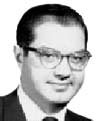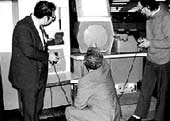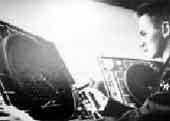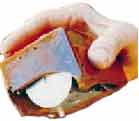History
Timeline
Second generation (1957 - 1964)

John Backus and his team develop the first FORTRAN compiler (FORmula TRANslator) for use in the development of scientific applications at IBM
Musasino I is built. Musasino I was a Japanese computer based on parametrons. Parametrons were invented by Eiichi Goto in 1954 and used as transistor substitutes
The Control Data Corporation is set up
Gordon Moore, Robert Noyce and others found Fairchild Semiconductor
The Soviet Union puts Sputnik I, the first artificial satellite in history, into orbit. This marked the beginning of the Space Race
The United States establishes the ARPA agency (Advanced Research Projects Agency) in response to the launch of Sputnik I
John McCarthy sets up the Artificial Intelligence Department at MIT (USA)
Two young engineers from MIT found the Digital Equipment Corporation (DEC) in Maynard (Massachusetts)

Working separately, Jack Kilby of Texas Instruments and Robert Noyce of Fairchild Semiconductor develop a prototype chip

The Bell company develops the Modem (MOdulator-DEModulator), a device for transmitting digital digital binary data over the conventional analog telephone line
John McCarthy develops the LISP language (LISt Processing), designed for artificial intelligence applications
The COmmittee on DAta SYstems Languages (CODASYL) is set up to develop COBOL (Common Business Oriented Language)
NEC presents NEAC 2201, the first fully transistorized commercial computer, at the UNESCO AUTOMATH Show in Paris

Xerox releases the first photocopier on to the market
Lyle R. Johnson introduces the concept of computer architecture into the design of the IBM 7000
Robert Noyce and Gordon Moore file a patent application for their integrated circuit technology

Paul Baran develops the groundwork of packet switching for data transmission
ALGOL-60 is developed. ALGOL-60 was the first standard language created by an international Committee and introduced structured programming
Frank Rosenblatt of Cornell University (USA) develops the perceptron, a model capable of learning by trial and error

Bull launches GAMMA 60 with multiprogramming capacity
DEC introduces PDP-1 (Programmed Data Processor), the first minicomputer
Kang and Atalla of Bell Labs build the first MOS transistor
The first International ICT Services and Solutions Trade Fair (SIMO) is held in Madrid
High-speed computers --IBM 7030, UNIVAC 1107, Honeywell 800, CDC 3600 and ATLAS— come on to the market
Georg C. Devol patents a robotic device that Unimation marketed as the first industrial robot. It was used to manufacture TV tubes
Fernando Corbató of MIT develops a procedure whereby multiple users share computer usage time. It was known as time-sharing
Fairchild Semiconductor sells the first integrated circuit
Max V. Mathews leads a group at Bell Labs developing software that can synthesize, store and edit music
The Universities of Stanford and Purdue establish the first Departments of Computer Science

Steve Russell, a MIT student, develops the first computer game
The Telstar satellite makes the first transatlantic transmission of TV images
The world's most powerful computer, ATLAS, is unveiled in England. It included a virtual memory and pipeline structures

Joseph Weizenbaum at MIT develops his computer psychologist Eliza, a seemingly intelligent system
The American National Standards Institute accepts 7-bit ASCII code for information exchange
Lofti Zadeh starts his work on fuzzy logic at the University of Berkeley

The SAGE system (Semi-Automated Ground Environment) is built for military defence. The estimated project cost was between eight and twelve billion dollars
The founder of Intel Gordon Moore foretells that the number of components in an integrated circuit would double every 18 months. This became known as Moore's Law
John Kemeny and Thomas E. Kurtz develop BASIC (Beginner's All-purpose Symbolic Instruction Code) at Dartmouth College

IBM launches the 360 system, first series of compatible computers

Dought Engelbart invents the mouse
CDC 6600 comes on the market. Designed by Seymour Cray and regarded as the first commercial supercomputer, it reached speeds of 9 megaflops
IBM completes the SABRE flight booking application
